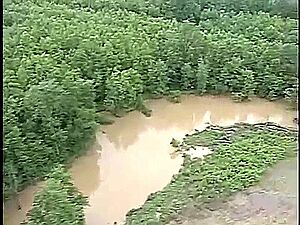Muscatatuck River facts for kids
The Muscatatuck River is a river in south-central Indiana, United States. It is about 54 miles (87 kilometers) long. The river is a major branch, or tributary, of the East Fork of the White River. It helps drain an area of about 1,000 square miles (2,600 square kilometers).
The Muscatatuck River flows through important natural areas. It forms the southern edge of the Muscatatuck National Wildlife Refuge. It also passes through the Crosley Fish and Wildlife Area and by Muscatatuck County Park. These places are important for wildlife and outdoor activities.
Contents
How the River Was Formed
The path of the Muscatatuck River was shaped by the ice age. Long ago, huge sheets of ice moved across the land. As the ice melted, it carved out the valleys and beds where the river now flows.
History of the River
People have lived near the Muscatatuck River for a very long time. It is thought that the first people arrived around 8000 BC. They built permanent homes along the river between 1000 BC and 1000 AD.
The first European settlers officially arrived in 1818. However, some people might have lived in the area even before Indiana became a state in 1816.
What Does the Name Mean?
In the early 1900s, the river was sometimes called "Muscackituck." It is believed that an early spelling was "Muscakituck" in 1812. Many people think the name comes from the Munsee language. The Munsee are a group of Native Americans. The name might mean "swamp river."
The Vernon Fork
The Vernon Fork is a longer branch of the Muscatatuck River. It is about 88.5 miles (142 kilometers) long. This branch is very important because it provides drinking water for the city of North Vernon.
Most of the Vernon Fork, about 59 miles (95 kilometers), flows through Jennings County. The town of Vernon is almost completely surrounded by the Vernon Fork. Only a small piece of land connects it to North Vernon.
River Travel and Bridges
Before 1830, the Muscatatuck River was deep enough for boats. Local settlers could use the river to ship goods like pork all the way to New Orleans. However, around 1830, the river became too shallow. Dirt and sand built up on the riverbed, making it hard for boats to pass.
Even though it's not used for shipping anymore, some groups still enjoy floating along parts of the river today.
The Cavanaugh Bridge crosses the Muscatatuck River. It is located southwest of Brownstown in Driftwood Township, Jackson County, Indiana. This historic bridge was added to the National Register of Historic Places in 2007.
The River in Art
A famous artist from Indiana, T. C. Steele, loved to paint the Muscatatuck River. He often featured the river in his beautiful landscape paintings.


